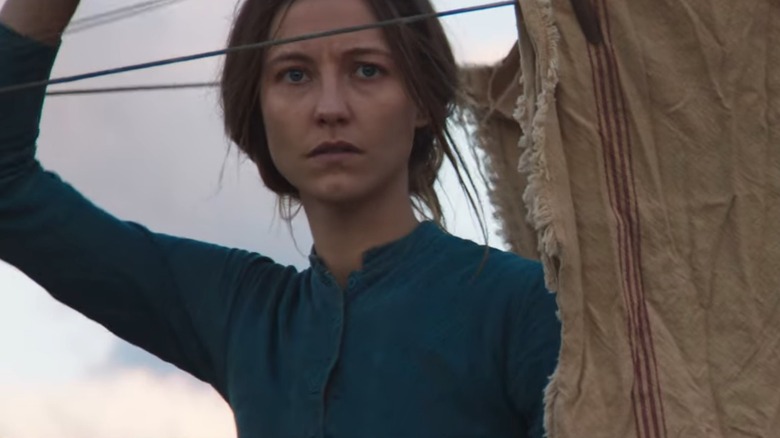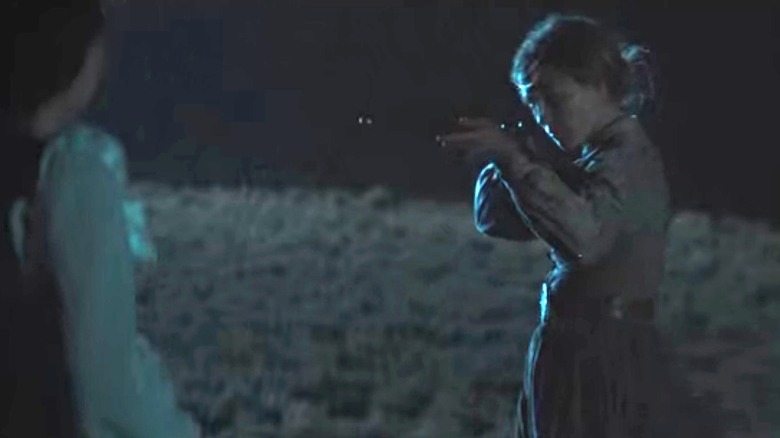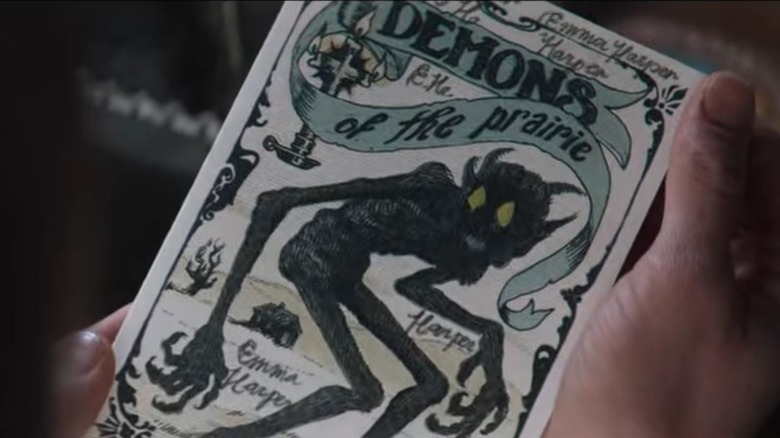The End Of The Wind Explained
The frontier of the American West in the 1800s was a difficult place to live, especially for women. The physical dangers were numerous, but in the 2018 horror film "The Wind" (which was added to Netflix in June), it's the psychological terrors that take focus.
Lizzy (Caitlin Gerard) and Isaac Macklin (Ashley Zukerman) live in isolation on a tract of land in New Mexico in the 1800s. That is, until another couple, Emma (Julia Goldani Telles) and Gideon Harper (Dylan McTee), move into a cabin nearby. At first, it seems pleasant to have others around. But the young couple is clearly not a happy one. Gideon is timid and ineffectual, while Emma soon begins to claim that she is being haunted by some kind of unseen entity that inhabits the scrubland that stretches out all around them.
"The Wind" tells its story through a non-linear narrative that begins with a pregnant Emma dying from a self-inflicted gunshot wound to the head. As the story jumps back and forth in time, we learn that leading up to her death, Emma's behavior had become increasingly erratic, while after her death, Lizzy has come to believe that she too is being menaced by the entity her neighbor claimed to hear whispering to her on the wind. Lizzy's fears are heightened when Isaac takes Gideon into town following Emma's death and a series of unnerving occurrences begin happening around her homestead.
The film's final act balances shocking reveals and enigmatic quandaries that will have even the most astute viewers questioning what is real. Here is the ending of "The Wind" explained.
Were the supernatural elements real, or a figment of Lizzy's imagination?
One of the biggest tensions in "The Wind" is the question of whether the occurrences Lizzy experiences are actually real. The movie is theoretically open to two different interpretations, one in which there is a literal demon inhabiting the prairie and one in which the supernatural events of the film are largely happening in Lizzy's mind.
On one hand, there are a number of physical manifestations of this alleged demon. Lizzy gets assaulted by it, the windows of her cabin are blown in, a goat she saw mauled to death by wolves comes back to life, and the local reverend (Miles Anderson) shapeshifts in front of her eyes, among other horrors.
On the other hand, there is evidence to suggest that these events are the result of Lizzy's paranoid imagination. It's revealed that Lizzy faced an extreme tragedy before the Harpers arrived in the form of a stillborn child. We also see things that may be influencing her perceptions, including witnessing Emma's emotional decline and Lizzy's interest in a pamphlet titled "Demons of the Prairie" (more on that later). Is it possible that Lizzy has actually been experiencing intense hallucinations brought on by her grief, isolation, and other outside influences?
There are some other very real plot developments that will help to further interpret the film's ending.
Emma's true fate is revealed
For much of "The Wind," the specter of Emma's suicide hangs over the proceedings. The film begins in the aftermath of her death and one of the earliest lines of dialogue sees Lizzy saying to Isaac, "She had my gun ... How did she get my gun?" That question isn't answered until the end of the film when it's revealed that Emma didn't actually shoot herself. It was, in fact, Lizzy who killed her.
The relationship between Lizzy and Emma begins on a friendly note but takes a turn when Lizzy starts to suspect that Emma is having an affair with Isaac. Her suspicions are confirmed when she finds Emma's diary in her cabin, which details not only her secret relationship with Isaac but also the fact that the baby Emma was carrying may have been his and not her husband's.
Late in the narrative, Isaac finds the diary in Lizzy's possession, which prompts him to realize that Lizzy likely had something to do with Emma's death. A flashback reveals that on the night she died, Emma and Lizzy met out in the prairie, where Emma revealed her intention to send Gideon away and live with Isaac, Lizzy, and the baby. After hearing this, Lizzy shoots and kills Emma.
Isaac confronts Lizzy about the murder. As he's doing so, she sees the demon manifest in the cabin. It seemingly possesses Isaac's body, leading Lizzy to stab him with a piece of broken glass. After he falls down dead, however, she seems unsure about her actions. While that is the climactic action of the story, the film's final moments give even more context to what came before.
The significance of the Demons of the Prairie pamphlet
After killing Isaac, Lizzy goes out to the prairie and stares into the horizon until the film ends. But not before there's one final flashback. This time, we see Lizzy encountering the Reverend during what we can presume to be one of the earliest days of the Macklin's arrival in New Mexico. The Reverend tries to give her a Bible, and when she shows him that she already has one, he then proffers the "Demons of the Prairie" pamphlet and says, "You can never be too prepared."
Throughout the movie, we've heard Emma repeating the names of the demons mentioned in the pamphlet, and toward the end, we even get a look at it. A trunk full of Emma and Gideon's books is moved into the Macklin cabin after Emma's death, which includes the dead woman's copy of "Demons of the Prairie."
When Lizzy opens it, the camera lingers long enough to see the list of demons and their attributes. There is Balban, the "invader of the weak mind" and "bringer of delusions," Jezebeth, the "seductress," Succorhenoth, the "bringer of jealous thoughts," and Vetis, the "shapeshifter," among others. You'll recognize delusion, jealousy, seduction, and shapeshifting as things Lizzy encounters during the movie.
In giving her the pamphlet, it seems that the Reverend was trying to prepare Lizzy for the hardships of frontier life. The demons described in the pamphlet could be interpreted as literal entities or merely a list of possible emotional and mental health issues that may be encountered when living in an inhospitable environment in extreme isolation.
Perhaps instead of questioning whether Lizzy's experiences were real or imagined, the film is trying to suggest that both things can be true at once. Lizzy did encounter the demons of the prairie, and even if they only existed in her mind, their power to destroy was still very real.



